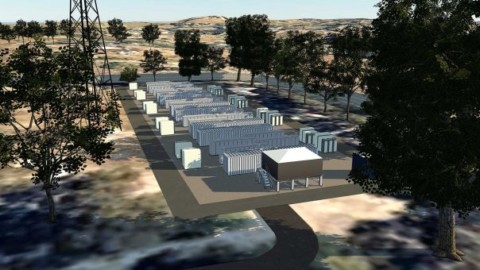by Andrew Dillon, Chief Executive Officer, Energy Networks Australia
With the expansion of solar energy already impacting our electricity grid – and with the volume only increasing in the years to come – the impact on our networks is going to be significant.
How we continue to manage the transition to bidirectional energy flows will have a critical impact on our networks, and networks are working to deliver the best path forward.
Solar saturation
The expansion of solar and other distributed energy resources (DER) has changed our grid, a distribution system originally designed for unidirectional power flow but now required to accommodate two-way flows that can fluctuate significantly within relatively short time periods.
The risk of reverse demand/power flows associated with high rooftop solar adoption has been a growing national issue, identified as a clear priority in the 2017 Energy Networks Australia and CSIRO Electricity Network Transformation Roadmap (ENTR).
With the rapid uptake of DER such as household solar and, increasingly, storage devices, a substantial proportion of Australia’s zone substations will reach reverse demand/power flows significantly earlier than previously thought.
This is a problem for the grid because, if unmanaged, it can cause voltage fluctuations resulting in localised power outages, damage to appliances and potentially even compromise electricity system security.
The indicative threshold for when reverse flows occur is when penetration of rooftop solar adoption reaches about 40 per cent – although this can vary, depending on the hosting capacity and topology of the electricity network.
The Open Energy Networks project, being delivered by Energy Networks Australia and the Australian Energy Market Operator (AEMO), has used updated data to map how soon zone substations will reach this threshold.
It shows almost a quarter of zone substations will likely hit 40 per cent solar penetration by 2025. This is slightly more pronounced in the populated areas of the coast, but not exclusively so.

How do we manage it?
In managing traditional distribution networks with unidirectional flow, there was limited need for control of the feeder as it was typically set up so that the range of anticipated voltage excursions did not exceed the allowable voltage limits.
However, with increased DER penetration, this is no longer possible in many cases without dramatic excursions outside the allowed voltage limits (with subsequent rooftop solar inverter tripping), unless dynamic control is implemented.
Given the relatively low level of monitoring and control that was implemented to cope with what was a relatively predictable operating regime, significant enhancement of monitoring and control functionality is required to provide for the robust connection of DER within the safe technical range of the network’s capacity, and to allow for the optimisation of the performance of the integrated network with its connected devices.
With the updated outlook, the enhancement of monitoring and control functionality required to manage the system when it goes into reverse demand will be required earlier for some sections of the network than previously thought.
Through the Open Energy Networks project, Energy Networks Australia is taking a lead role in this adaption by redesigning the management of DER in partnership with AEMO.
The best way to manage voltage issues and integrate increasing levels of solar and storage into the system is to develop a smarter and more flexible grid. Electricity networks are working towards being coordinated and optimised both locally and across the wider energy system – Open Energy Networks is examining how best to do this.

Demand shift
The rapid growth of household solar means far more electricity is now generated in the middle of the day and supply often exceeds demand. This is called a solar trough, or the back of the ‘duck curve’. It can cause grid instability and reliability issues.
In the evening, when the sun goes down but everyone gets home from work, demand spikes – again putting pressure on the grid – and wholesale prices rise so all customers are impacted by higher bills. Managing these shifting sands by simply investing more in infrastructure is one way of dealing with this, but that also results in all customers paying more.
Time of use tariffs
Everyone’s heard of time-of-use tariffs. They’re intended to price services (typically utility-type or publicly funded/subsidised) to manage demand and congestion – and are therefore more expensive during high-use periods and cheaper in lower-use periods. This incentivises more efficient consumption patterns from customers.
For energy customers, this type of pricing offers significant potential benefits.
It makes far more sense to implement pricing signals to smooth out the ever-growing trough and peak periods, encouraging less electricity use at peak demand times and more at lower demand times.
If enough customers use less energy at peak periods by shifting their consumption to other times of the day or by simply using less, network augmentation can be delayed or prevented. This means cheaper prices for customers.

If customers can easily shift their consumption away from peak periods, then they can take advantage of a retailer’s time-of-use offer and save on their electricity bills.
The South Australian Power Network estimates a customer with an electric vehicle on a time-of-use tariff and charging the electric vehicle in the middle of the day could save as much as $500 per annum compared with a flat retail price.
The reality of an increasingly distributed energy landscape presents challenges that must be managed not only with engineering solutions, but by influencing and managing consumption behaviour.
Time of use pricing structures are as essential as engineering innovations to not only avoid the network infrastructure investment that would otherwise be needed, but to improve pricing equity and maximise the benefits of the DER evolution for all end-use customers.


















Why not using battery storage at an industrial level by the big power generation companies to store the produced energy through DER and releasing it during peak times? Batteries are still expensive for households, but seem to be viable on an industrial scale for big generation companies, are they not?